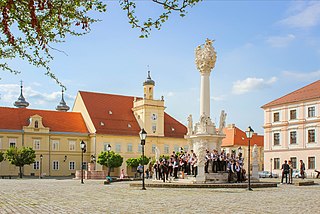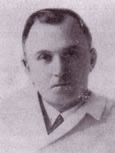
Osijek is the fourth-largest city in Croatia, with a population of 96,848 in 2021. It is the largest city and the economic and cultural centre of the eastern Croatian region of Slavonia, as well as the administrative centre of Osijek-Baranja County. Osijek is on the right bank of the Drava River, 25 km (16 mi) upstream of its confluence with the Danube, at an elevation of 94 m (308 ft).
Ferdo Šišić was a Croatian historian, the founding figure of the Croatian historiography of the 20th century. He made his most important contributions in the area of the Croatian early Middle Ages.

Viktor Axmann was a Croatian architect. He spent most of his life in Osijek, but he died in 1946 in a communist labor camp in Valpovo.

The Holocaust in the Independent State of Croatia involved the genocide of Jews, Serbs and Romani within the Independent State of Croatia, a fascist puppet state that existed during World War II, led by the Ustaše regime, which ruled an occupied area of Yugoslavia including most of the territory of modern-day Croatia, the whole of modern-day Bosnia and Herzegovina and the eastern part of Syrmia (Serbia). Of the 39,000 Jews who lived in the NDH in 1941, the United States Holocaust Memorial Museum states that more than 30,000 were murdered. Of these, 6,200 were shipped to Nazi Germany and the rest of them were murdered in the NDH, the vast majority in Ustaše-run concentration camps, such as Jasenovac. The Ustaše were the only quisling forces in Yugoslavia who operated their own extermination camps for the purpose of murdering Jews and members of other ethnic groups.

Louis Svećenski was a notable Croatian-American violist, violinist and rector of the Boston Academy of Music.
Ignjat Nathan Fischer was a Croatian architect who was active in Zagreb during the first half of the 20th century.

Dr. Miroslav Feldman was a Croatian-Jewish poet and writer. Feldman was born in Virovitica on 28 December 1899. He studied medicine in Zagreb and Vienna. After graduation, he returned to Croatia and worked as a physician in Virovitica, Osijek, Pakrac, Sarajevo and Zagreb. During World War II he joined the Partisans, where he helped organize the medical corps.

Lav Mirski was a Croatian-Jewish conductor.

Ignjat Granitz was a Croatian-Jewish industrialist, philanthropist and publisher.

Viktor Alexander was a well-known Croatian lawyer and public prosecutor in Zagreb, the capital of Croatia.
Arnold Kohn was a Croatian Zionist, longtime president of the Jewish community Osijek and Holocaust survivor.

Dr. Slavko Hirsch was a Croatian physician, founder and director of the Epidemiological Institute in Osijek.
Dr. Karlo Weissmann was a Croatian physician and founder of the first sanatorium in Osijek.
Dr. Simon Ungar (1864–1942) was a doctor of oriental medicine and rabbi of the Osijek Jewish Community who was killed during the Holocaust.
Herman Ehrlich was a Croatian architect and businessman.

Ing. Mihajlo Klajn was a Yugoslav agronomist and communist who was killed during the Holocaust in the Independent State of Croatia.

Izidor (Iso) Kršnjavi was a Croatian painter, art historian, curator and politician.
Freemasonry in Croatia may be traced to the second half of the 18th century when it was introduced by the officers that came back from the Seven Years' War (1756–1763). However, the fraternity has been repeatedly banned and re-founded since then.

The Tenja concentration camp was one of 26 concentration camps established in the Independent State of Croatia during World War II. It was located close to village of Tenja near Osijek and operated by Ustaše.











